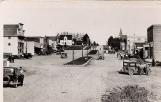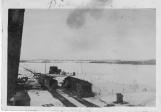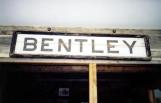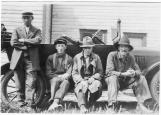3
StagecoachThe first regular scheduled public transportation was the stagecoach operated and owned by Alfred Coverdale between 1903 and 1911, on a route which went from Lacombe to Gull Lake, on to Bentley and then north up the famous Blindman Valley to Forshee and Rimbey.
Soon after settling near Rimbey, Coverdale, an ex-railway conductor had been awarded the contract to haul the Royal mail, carrying mails between Lacombe and Rimbey. Besides mail, the coach, hauled by a team of Cleveland bays named Dolly and Pet, carried both passengers and express freight. Mr. Cloverdale's railroad background was very apparent in his arrival and departure time. He tried to keep a punctual schedule. Drivers included Ralph Mowbray, Henry Castleman, Stuart Gillen, Sam Christopherson and Merton Challand. Roads at that time were very rough, so passengers would be weary at the end of their ride. If there had been rain, the stagecoach quite often got stuck in the mud! The stagecoach always stopped in Bentley long enough for the passengers and the driver to have a short break and of course, some lunch. This would also give the horses a little time to rest too.
Each trip took a day to complete or two days for the round trip. In the beginning the stagecoach made one round trip each week, but as business grew the schedule was increased to two round trips each week and finally the trip was made daily.
Now this journey can be made in approximately half an hour by air conditioned cars on paved roads, - Talk about progress!
8
The first train over the Lacombe Branch of the C. P. R.1917
Rural Bentley Alberta
 Credits:
Credits:Bentley Museum Society
11
The RailroadThe first settlers in our area soon realized that during much of the year the trails were not suited for heavier traffic. In the spring and after a rain storm deep mud holes were fairly common. In the winter, travel was a little easier by driving on the ice of Gull Lake. Of course this had its hazards too, as sometimes the horses and sleds broke through the ice. The farmers especially wanted a railroad.
When the prospects of the C.N.R. going through Lacombe, became conclusive, the idea of a short line running from Lacombe to Rimbey, and touching at Bentley and Gull Lake, also seemed possible. To the farmers and businessmen of the area, a railway seemed an efficient and inexpensive means of transporting goods to and from Edmonton and Calgary.
In 1909, thanks to a group of eighteen farmers, business and professional men from Lacombe, Gull Lake, Bentley and Rimbey, the plan of a railroad became a very thought after idea. The group was headed by Major William McPherson and included William Wiese of Gull Lake. A need for better communication between Lacombe and the growing west country was recognized. The wheels of progress were in motion. They originally planned for an electric railway as there was an electric railway craze sweeping the country at that time. This group of men obtained a charter for the building of a railway, and the Lacombe and Blindman Valley Electric Railway Company was incorporated.
Grading of this line began in September 1913. Many enthusiastic local farmers assisted using their own teams. Grading was impossible during the winter but resumed again in April 1914. Mainly due to the outbreak of World War 1, work was temporarily halted and therefore, the line didn't reach Bentley until November 28, 1917. It was financed to a large degree by local capital, and second hand rails were installed on the graded bed.
It was a day of special significance to Bentley. This train, "The Peanut Special", shunted into Bentley, the first to arrive from Lacombe on the newly constructed railroad track, a distance of fifteen miles. It had been four years in the making. It was a real banner day when the steam engine chugged,, puffed and screeched to a stop on its first run west. There was no station office then and the tracks which now twist north through Rimbey, Winfield and Breton were non-existent. The train backed into Bentley, so that it would be pointed in the right direction to go "Home" to Lacombe. Later, a siding and "Y" were built for the train to turn around. This historic day, November 28, 1917 was a "Red Letter Day" for the Bentley settlers. This wasn't the largest railroad in the world - but what an example of independence and pioneer initiative by farmers and citizens of "THE BENTLEY AREA".
The arrival of the train in Bentley was a special day for the Bentley High School students. At the time they were being schooled in the old Methodist log church. Their teacher, Mrs Rosco took them to watch the train arrive. Not only did they get to miss classes, but they witnessed a historical event.
The notion of using electric traction was soon set aside in favor of more conventional locomotives. It seems at one time there was an oil turbine trolley car (electric) and then a gasoline outfit. They finally settled on a small steam engine nicknamed the "Peanut". This steam locomotive was more suitable, not only for staying on the tracks, but for transporting goods for the local residents. The other engines couldn't handle the prairie winters, and had a bad habit of derailing on icy curves in cold stormy weather. The railroad was affectionately called the "Peanut Line". The official name was changed to The Lacombe and North Western Railway, in 1919. This train carried passengers, mail, express and freight. The crew was nicknamed the "Outlaws", as some of them had been fired by the C.P.R. The service was up one day and back the next. It wasn't always very prompt. You could expect it when it arrived. Throughout the twenty year history of the company, the line was known as the "Peanut Special", the "22 Short", and the "Toonerville Trolley".
The attitude among some was that, because they had helped build the railroad line,they should be able to travel free. As a result, a clause in the charter allowed any passenger convicted of not paying the fare or not producing a ticket when requested to be liable to a fine of between $2.00 and $10.00. In practice a passenger beginning a rail trip simply calculated whether the fare or fine would be cheaper, and paid accordingly.
It was not unusual to see the original "Peanut" stopped along its route. The line passed through good blueberry country and offered the perfect opportunity for an afternoon snack. A local newspaper reported that it was customary for the engineer to stop the train and let the passengers "indulge in a little hunting", when game was abundant along the route. The car could also be seen backing up to accommodate passengers running across the field to catch it. The "Peanut" stopped wherever there were passengers requiring a ride.
On July 21, 1929, the "Peanut Special" chugged to a halt. The 999 year lease of the Lacombe and North Western Railway Co to the Canadian Pacific Co. was officially approved on September 25, 1929. Who, knows maybe the local residents will want their railway back when the lease terminates on July 1, 2928.
The final stages of construction continued in fits and starts. Some local residents became so frustrated that they went to the end of the steel and continued the construction on their own. The government immediately authorized further work and the rail reached Rimbey in October 1919. In 1922 construction continued north to Hoadley. This made for many changes along the line. A freight warehouse at Bentley was converted into a pair of station buildings. By 1925 the line had reached Winfield and on to Breton in 1925.
The coming of the railroad brought many changes to Bentley. It became a booming town. The town got a station agent and a section foreman and his crew. Livestock was hauled by rail. Bentley had its drayman who hauled freight to and from the rail.
The aged, but picturesque trestle bridge about one mile north of Bentley has been permanently put to rest by the CPR and was replaced with a land fill that allows the tracks to stay on solid ground. The workers built a large hill to accommodate the tracks and installed a series of culverts which allows a stream at the valley bottom to continue on its way. The stream is the outlet which flows from Gull Lake into the Blindman River. The culvert under the rail track is huge. People can walk in it with lots of head clearance. The front of this culvert has a huge disc like perforated screen which protects the series of culverts from receiving any debris that floats down the river.
There have been many changes. In 1928 -29 Canadian Pacific took over the line. In the early 1960's a branch line was constructed to the Rimbey Gas Plant and the line north of Rimbey was abandoned. All passenger service ended in recent years. The grain car service has dwindled to almost nil. The train today usually makes scheduled trips five days a week to the Rimbey Gas Plant.
12
50th Avenue (Main Street ) in BentleyEarly 1900's
Bentley, Alberta
 Credits:
Credits:Bentley Museum Society
Bentley Volunteers









